Management of Chronic Disease Portfolio: NUR09721, Singapore
VerifiedAdded on 2022/11/01
|18
|5303
|437
Portfolio
AI Summary
This portfolio delves into the management of chronic diseases, specifically focusing on stroke. It begins with an introduction that defines chronic conditions and highlights the global prevalence and impact of stroke, citing statistics from the World Health Organization and other sources. The portfolio then explores the pathophysiology of stroke, differentiating between ischemic and hemorrhagic strokes, detailing the mechanisms of cerebral ischemia, cellular changes, and risk factors. A case study of a 78-year-old patient with a history of hypertension, hyperlipidemia, and type 2 diabetes is presented, illustrating the clinical presentation and complications of stroke, particularly dysphagia. Finally, the portfolio discusses assessment tools for dysphagia, such as FEES (Fiberoptic Endoscopic Evaluation of Swallowing), outlining its advantages and application in clinical practice.

Running head: CHRONIC DISEASE
Chronic Disease
Name of the Student
Name of the University
Author Note
Chronic Disease
Name of the Student
Name of the University
Author Note
Paraphrase This Document
Need a fresh take? Get an instant paraphrase of this document with our AI Paraphraser
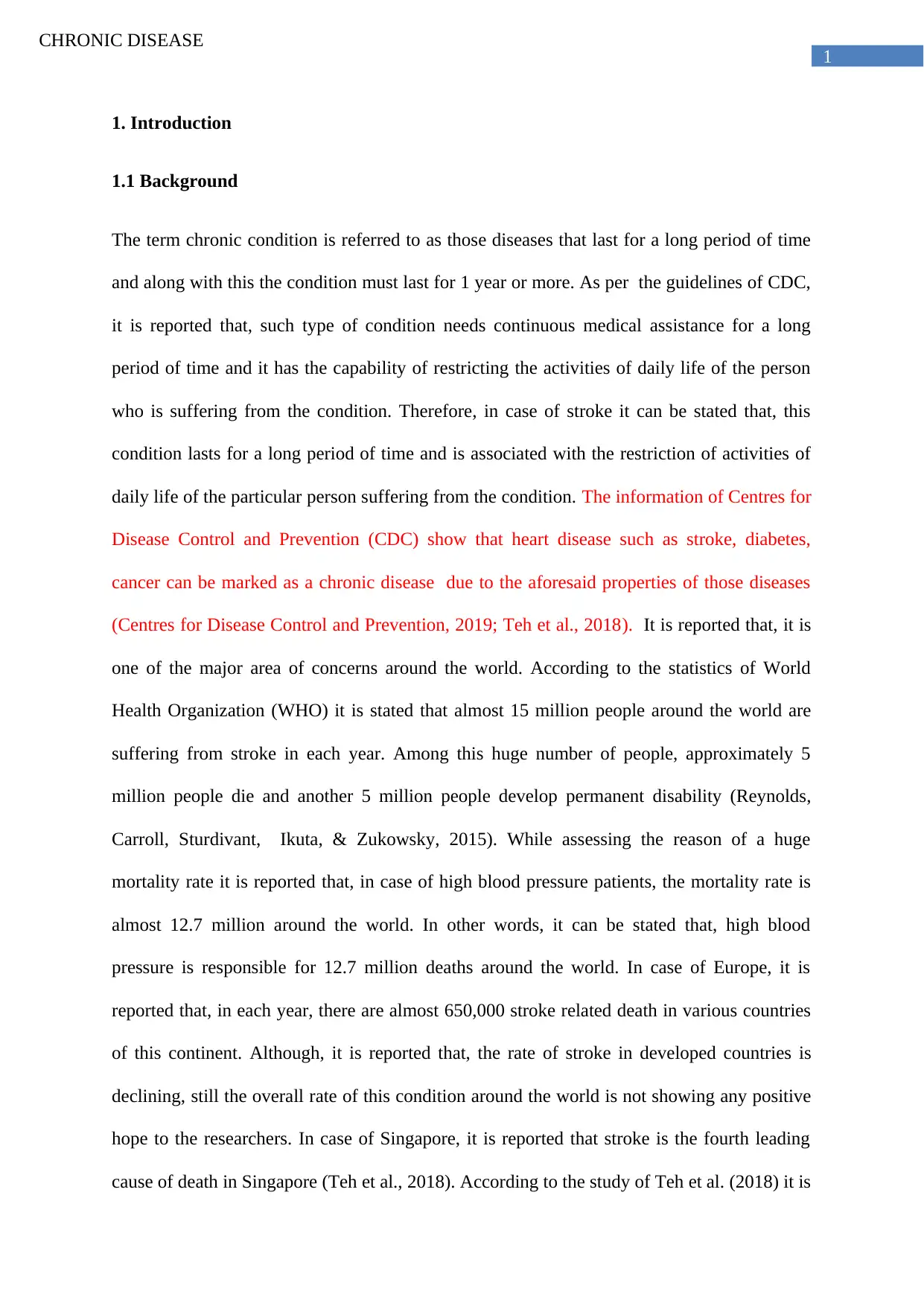
1
CHRONIC DISEASE
1. Introduction
1.1 Background
The term chronic condition is referred to as those diseases that last for a long period of time
and along with this the condition must last for 1 year or more. As per the guidelines of CDC,
it is reported that, such type of condition needs continuous medical assistance for a long
period of time and it has the capability of restricting the activities of daily life of the person
who is suffering from the condition. Therefore, in case of stroke it can be stated that, this
condition lasts for a long period of time and is associated with the restriction of activities of
daily life of the particular person suffering from the condition. The information of Centres for
Disease Control and Prevention (CDC) show that heart disease such as stroke, diabetes,
cancer can be marked as a chronic disease due to the aforesaid properties of those diseases
(Centres for Disease Control and Prevention, 2019; Teh et al., 2018). It is reported that, it is
one of the major area of concerns around the world. According to the statistics of World
Health Organization (WHO) it is stated that almost 15 million people around the world are
suffering from stroke in each year. Among this huge number of people, approximately 5
million people die and another 5 million people develop permanent disability (Reynolds,
Carroll, Sturdivant, Ikuta, & Zukowsky, 2015). While assessing the reason of a huge
mortality rate it is reported that, in case of high blood pressure patients, the mortality rate is
almost 12.7 million around the world. In other words, it can be stated that, high blood
pressure is responsible for 12.7 million deaths around the world. In case of Europe, it is
reported that, in each year, there are almost 650,000 stroke related death in various countries
of this continent. Although, it is reported that, the rate of stroke in developed countries is
declining, still the overall rate of this condition around the world is not showing any positive
hope to the researchers. In case of Singapore, it is reported that stroke is the fourth leading
cause of death in Singapore (Teh et al., 2018). According to the study of Teh et al. (2018) it is
CHRONIC DISEASE
1. Introduction
1.1 Background
The term chronic condition is referred to as those diseases that last for a long period of time
and along with this the condition must last for 1 year or more. As per the guidelines of CDC,
it is reported that, such type of condition needs continuous medical assistance for a long
period of time and it has the capability of restricting the activities of daily life of the person
who is suffering from the condition. Therefore, in case of stroke it can be stated that, this
condition lasts for a long period of time and is associated with the restriction of activities of
daily life of the particular person suffering from the condition. The information of Centres for
Disease Control and Prevention (CDC) show that heart disease such as stroke, diabetes,
cancer can be marked as a chronic disease due to the aforesaid properties of those diseases
(Centres for Disease Control and Prevention, 2019; Teh et al., 2018). It is reported that, it is
one of the major area of concerns around the world. According to the statistics of World
Health Organization (WHO) it is stated that almost 15 million people around the world are
suffering from stroke in each year. Among this huge number of people, approximately 5
million people die and another 5 million people develop permanent disability (Reynolds,
Carroll, Sturdivant, Ikuta, & Zukowsky, 2015). While assessing the reason of a huge
mortality rate it is reported that, in case of high blood pressure patients, the mortality rate is
almost 12.7 million around the world. In other words, it can be stated that, high blood
pressure is responsible for 12.7 million deaths around the world. In case of Europe, it is
reported that, in each year, there are almost 650,000 stroke related death in various countries
of this continent. Although, it is reported that, the rate of stroke in developed countries is
declining, still the overall rate of this condition around the world is not showing any positive
hope to the researchers. In case of Singapore, it is reported that stroke is the fourth leading
cause of death in Singapore (Teh et al., 2018). According to the study of Teh et al. (2018) it is
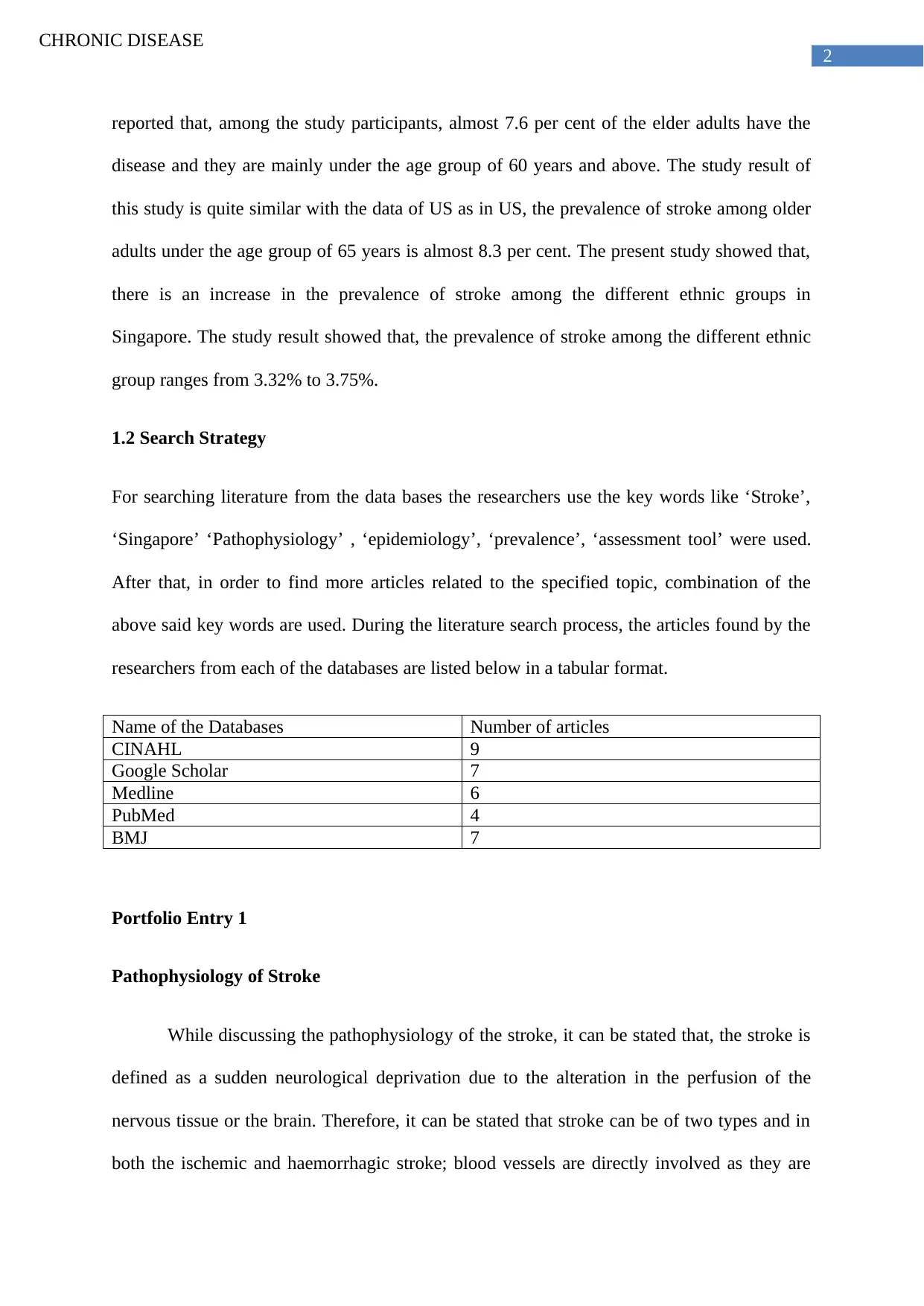
2
CHRONIC DISEASE
reported that, among the study participants, almost 7.6 per cent of the elder adults have the
disease and they are mainly under the age group of 60 years and above. The study result of
this study is quite similar with the data of US as in US, the prevalence of stroke among older
adults under the age group of 65 years is almost 8.3 per cent. The present study showed that,
there is an increase in the prevalence of stroke among the different ethnic groups in
Singapore. The study result showed that, the prevalence of stroke among the different ethnic
group ranges from 3.32% to 3.75%.
1.2 Search Strategy
For searching literature from the data bases the researchers use the key words like ‘Stroke’,
‘Singapore’ ‘Pathophysiology’ , ‘epidemiology’, ‘prevalence’, ‘assessment tool’ were used.
After that, in order to find more articles related to the specified topic, combination of the
above said key words are used. During the literature search process, the articles found by the
researchers from each of the databases are listed below in a tabular format.
Name of the Databases Number of articles
CINAHL 9
Google Scholar 7
Medline 6
PubMed 4
BMJ 7
Portfolio Entry 1
Pathophysiology of Stroke
While discussing the pathophysiology of the stroke, it can be stated that, the stroke is
defined as a sudden neurological deprivation due to the alteration in the perfusion of the
nervous tissue or the brain. Therefore, it can be stated that stroke can be of two types and in
both the ischemic and haemorrhagic stroke; blood vessels are directly involved as they are
CHRONIC DISEASE
reported that, among the study participants, almost 7.6 per cent of the elder adults have the
disease and they are mainly under the age group of 60 years and above. The study result of
this study is quite similar with the data of US as in US, the prevalence of stroke among older
adults under the age group of 65 years is almost 8.3 per cent. The present study showed that,
there is an increase in the prevalence of stroke among the different ethnic groups in
Singapore. The study result showed that, the prevalence of stroke among the different ethnic
group ranges from 3.32% to 3.75%.
1.2 Search Strategy
For searching literature from the data bases the researchers use the key words like ‘Stroke’,
‘Singapore’ ‘Pathophysiology’ , ‘epidemiology’, ‘prevalence’, ‘assessment tool’ were used.
After that, in order to find more articles related to the specified topic, combination of the
above said key words are used. During the literature search process, the articles found by the
researchers from each of the databases are listed below in a tabular format.
Name of the Databases Number of articles
CINAHL 9
Google Scholar 7
Medline 6
PubMed 4
BMJ 7
Portfolio Entry 1
Pathophysiology of Stroke
While discussing the pathophysiology of the stroke, it can be stated that, the stroke is
defined as a sudden neurological deprivation due to the alteration in the perfusion of the
nervous tissue or the brain. Therefore, it can be stated that stroke can be of two types and in
both the ischemic and haemorrhagic stroke; blood vessels are directly involved as they are
⊘ This is a preview!⊘
Do you want full access?
Subscribe today to unlock all pages.

Trusted by 1+ million students worldwide
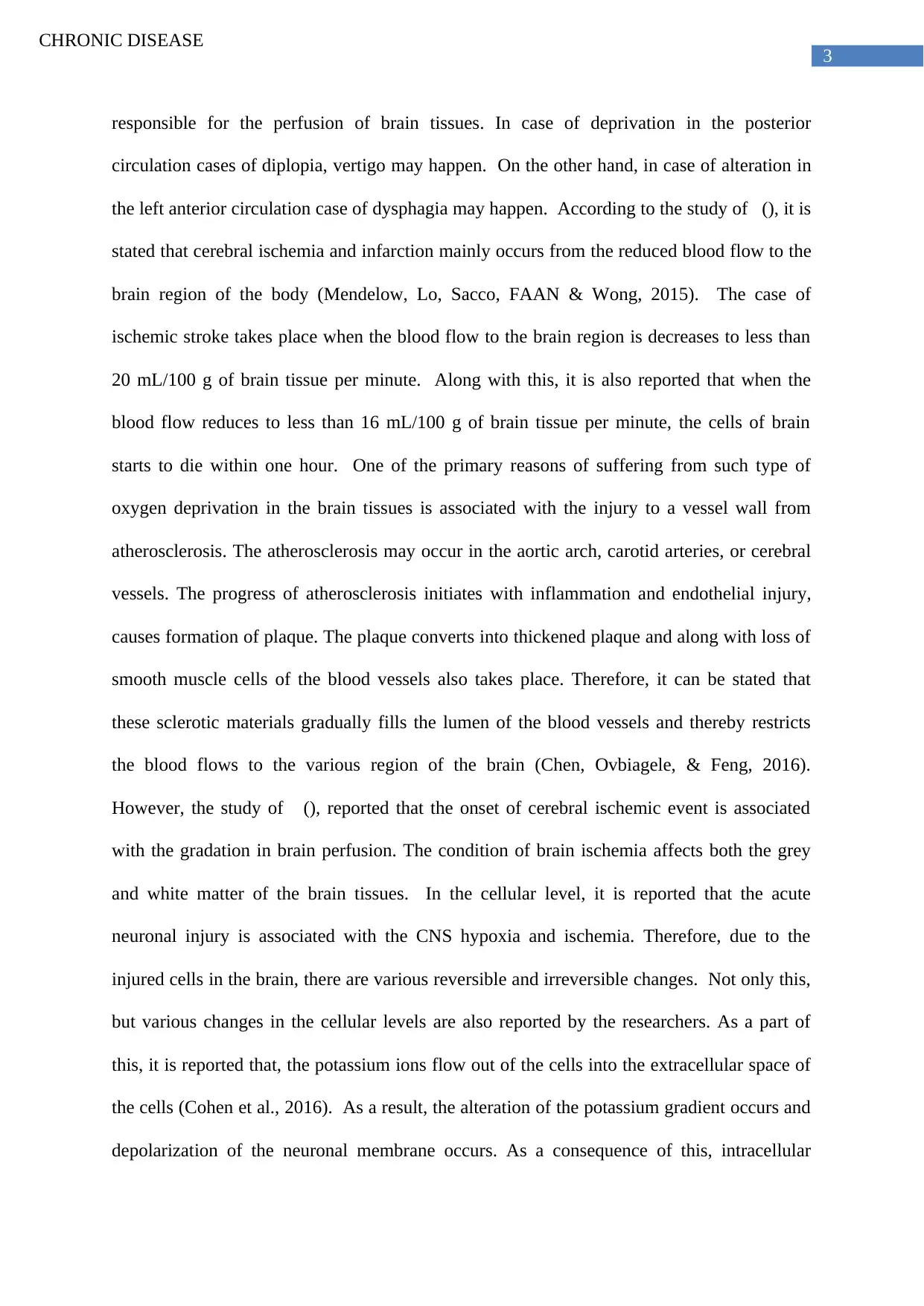
3
CHRONIC DISEASE
responsible for the perfusion of brain tissues. In case of deprivation in the posterior
circulation cases of diplopia, vertigo may happen. On the other hand, in case of alteration in
the left anterior circulation case of dysphagia may happen. According to the study of (), it is
stated that cerebral ischemia and infarction mainly occurs from the reduced blood flow to the
brain region of the body (Mendelow, Lo, Sacco, FAAN & Wong, 2015). The case of
ischemic stroke takes place when the blood flow to the brain region is decreases to less than
20 mL/100 g of brain tissue per minute. Along with this, it is also reported that when the
blood flow reduces to less than 16 mL/100 g of brain tissue per minute, the cells of brain
starts to die within one hour. One of the primary reasons of suffering from such type of
oxygen deprivation in the brain tissues is associated with the injury to a vessel wall from
atherosclerosis. The atherosclerosis may occur in the aortic arch, carotid arteries, or cerebral
vessels. The progress of atherosclerosis initiates with inflammation and endothelial injury,
causes formation of plaque. The plaque converts into thickened plaque and along with loss of
smooth muscle cells of the blood vessels also takes place. Therefore, it can be stated that
these sclerotic materials gradually fills the lumen of the blood vessels and thereby restricts
the blood flows to the various region of the brain (Chen, Ovbiagele, & Feng, 2016).
However, the study of (), reported that the onset of cerebral ischemic event is associated
with the gradation in brain perfusion. The condition of brain ischemia affects both the grey
and white matter of the brain tissues. In the cellular level, it is reported that the acute
neuronal injury is associated with the CNS hypoxia and ischemia. Therefore, due to the
injured cells in the brain, there are various reversible and irreversible changes. Not only this,
but various changes in the cellular levels are also reported by the researchers. As a part of
this, it is reported that, the potassium ions flow out of the cells into the extracellular space of
the cells (Cohen et al., 2016). As a result, the alteration of the potassium gradient occurs and
depolarization of the neuronal membrane occurs. As a consequence of this, intracellular
CHRONIC DISEASE
responsible for the perfusion of brain tissues. In case of deprivation in the posterior
circulation cases of diplopia, vertigo may happen. On the other hand, in case of alteration in
the left anterior circulation case of dysphagia may happen. According to the study of (), it is
stated that cerebral ischemia and infarction mainly occurs from the reduced blood flow to the
brain region of the body (Mendelow, Lo, Sacco, FAAN & Wong, 2015). The case of
ischemic stroke takes place when the blood flow to the brain region is decreases to less than
20 mL/100 g of brain tissue per minute. Along with this, it is also reported that when the
blood flow reduces to less than 16 mL/100 g of brain tissue per minute, the cells of brain
starts to die within one hour. One of the primary reasons of suffering from such type of
oxygen deprivation in the brain tissues is associated with the injury to a vessel wall from
atherosclerosis. The atherosclerosis may occur in the aortic arch, carotid arteries, or cerebral
vessels. The progress of atherosclerosis initiates with inflammation and endothelial injury,
causes formation of plaque. The plaque converts into thickened plaque and along with loss of
smooth muscle cells of the blood vessels also takes place. Therefore, it can be stated that
these sclerotic materials gradually fills the lumen of the blood vessels and thereby restricts
the blood flows to the various region of the brain (Chen, Ovbiagele, & Feng, 2016).
However, the study of (), reported that the onset of cerebral ischemic event is associated
with the gradation in brain perfusion. The condition of brain ischemia affects both the grey
and white matter of the brain tissues. In the cellular level, it is reported that the acute
neuronal injury is associated with the CNS hypoxia and ischemia. Therefore, due to the
injured cells in the brain, there are various reversible and irreversible changes. Not only this,
but various changes in the cellular levels are also reported by the researchers. As a part of
this, it is reported that, the potassium ions flow out of the cells into the extracellular space of
the cells (Cohen et al., 2016). As a result, the alteration of the potassium gradient occurs and
depolarization of the neuronal membrane occurs. As a consequence of this, intracellular
Paraphrase This Document
Need a fresh take? Get an instant paraphrase of this document with our AI Paraphraser
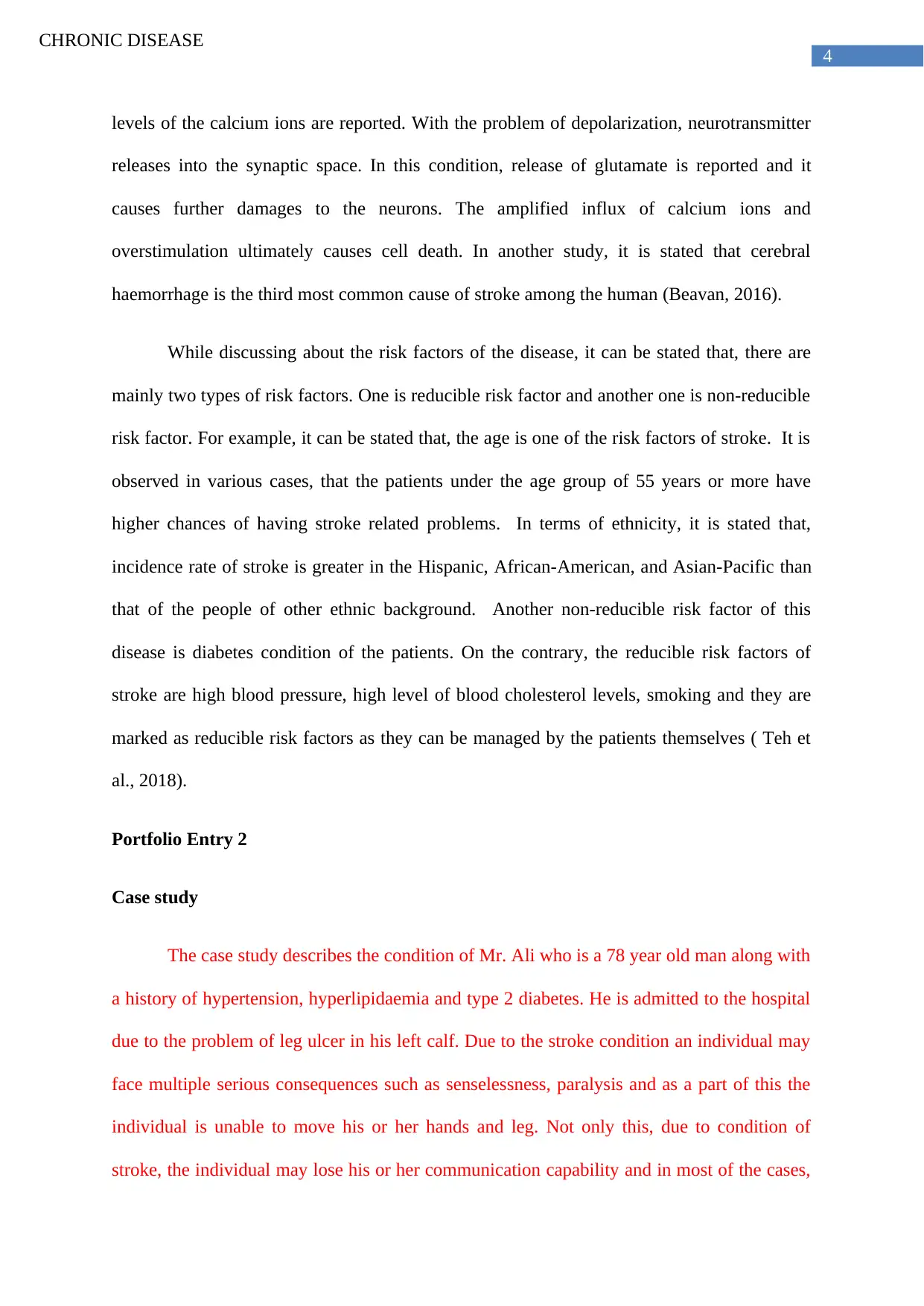
4
CHRONIC DISEASE
levels of the calcium ions are reported. With the problem of depolarization, neurotransmitter
releases into the synaptic space. In this condition, release of glutamate is reported and it
causes further damages to the neurons. The amplified influx of calcium ions and
overstimulation ultimately causes cell death. In another study, it is stated that cerebral
haemorrhage is the third most common cause of stroke among the human (Beavan, 2016).
While discussing about the risk factors of the disease, it can be stated that, there are
mainly two types of risk factors. One is reducible risk factor and another one is non-reducible
risk factor. For example, it can be stated that, the age is one of the risk factors of stroke. It is
observed in various cases, that the patients under the age group of 55 years or more have
higher chances of having stroke related problems. In terms of ethnicity, it is stated that,
incidence rate of stroke is greater in the Hispanic, African-American, and Asian-Pacific than
that of the people of other ethnic background. Another non-reducible risk factor of this
disease is diabetes condition of the patients. On the contrary, the reducible risk factors of
stroke are high blood pressure, high level of blood cholesterol levels, smoking and they are
marked as reducible risk factors as they can be managed by the patients themselves ( Teh et
al., 2018).
Portfolio Entry 2
Case study
The case study describes the condition of Mr. Ali who is a 78 year old man along with
a history of hypertension, hyperlipidaemia and type 2 diabetes. He is admitted to the hospital
due to the problem of leg ulcer in his left calf. Due to the stroke condition an individual may
face multiple serious consequences such as senselessness, paralysis and as a part of this the
individual is unable to move his or her hands and leg. Not only this, due to condition of
stroke, the individual may lose his or her communication capability and in most of the cases,
CHRONIC DISEASE
levels of the calcium ions are reported. With the problem of depolarization, neurotransmitter
releases into the synaptic space. In this condition, release of glutamate is reported and it
causes further damages to the neurons. The amplified influx of calcium ions and
overstimulation ultimately causes cell death. In another study, it is stated that cerebral
haemorrhage is the third most common cause of stroke among the human (Beavan, 2016).
While discussing about the risk factors of the disease, it can be stated that, there are
mainly two types of risk factors. One is reducible risk factor and another one is non-reducible
risk factor. For example, it can be stated that, the age is one of the risk factors of stroke. It is
observed in various cases, that the patients under the age group of 55 years or more have
higher chances of having stroke related problems. In terms of ethnicity, it is stated that,
incidence rate of stroke is greater in the Hispanic, African-American, and Asian-Pacific than
that of the people of other ethnic background. Another non-reducible risk factor of this
disease is diabetes condition of the patients. On the contrary, the reducible risk factors of
stroke are high blood pressure, high level of blood cholesterol levels, smoking and they are
marked as reducible risk factors as they can be managed by the patients themselves ( Teh et
al., 2018).
Portfolio Entry 2
Case study
The case study describes the condition of Mr. Ali who is a 78 year old man along with
a history of hypertension, hyperlipidaemia and type 2 diabetes. He is admitted to the hospital
due to the problem of leg ulcer in his left calf. Due to the stroke condition an individual may
face multiple serious consequences such as senselessness, paralysis and as a part of this the
individual is unable to move his or her hands and leg. Not only this, due to condition of
stroke, the individual may lose his or her communication capability and in most of the cases,
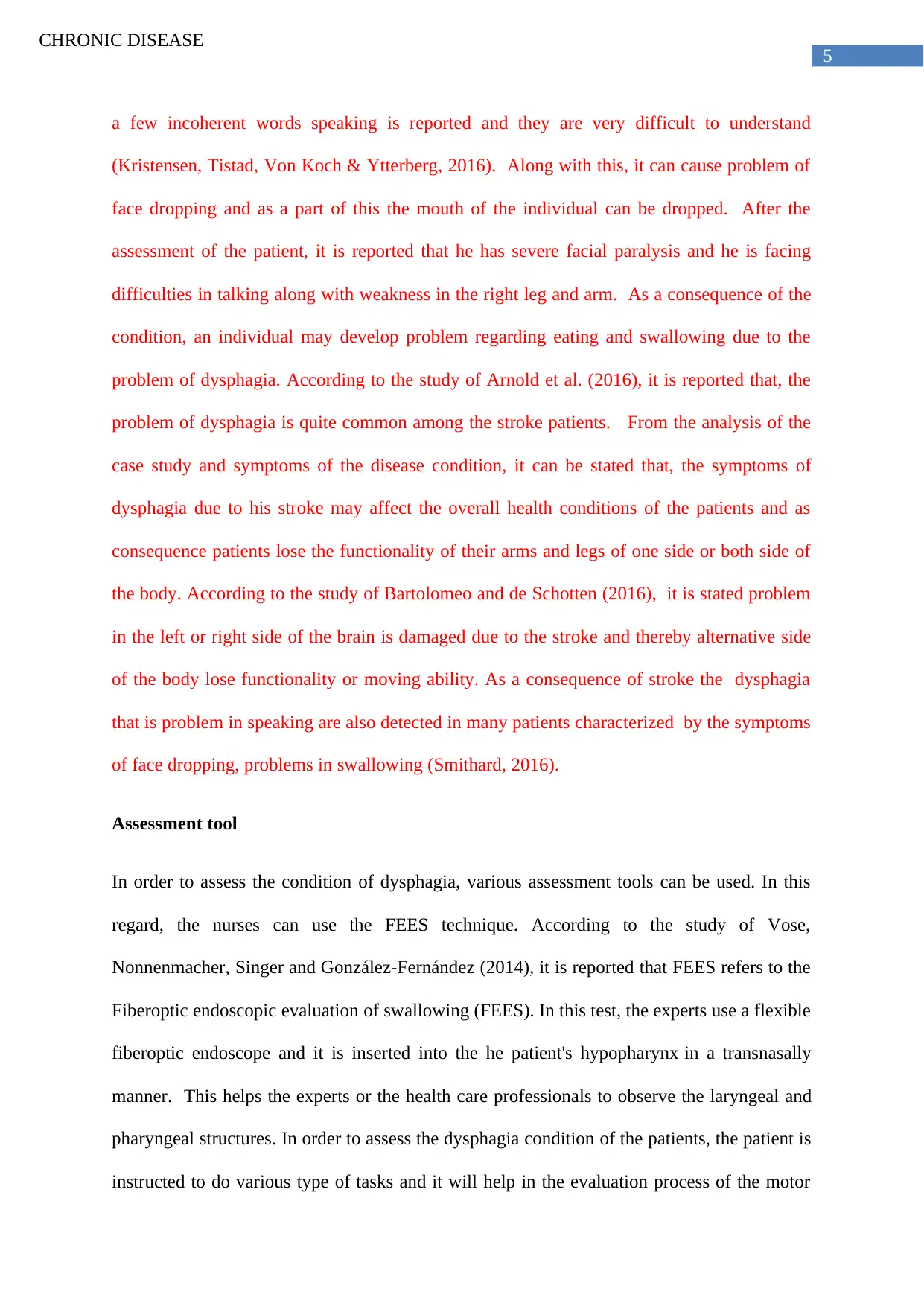
5
CHRONIC DISEASE
a few incoherent words speaking is reported and they are very difficult to understand
(Kristensen, Tistad, Von Koch & Ytterberg, 2016). Along with this, it can cause problem of
face dropping and as a part of this the mouth of the individual can be dropped. After the
assessment of the patient, it is reported that he has severe facial paralysis and he is facing
difficulties in talking along with weakness in the right leg and arm. As a consequence of the
condition, an individual may develop problem regarding eating and swallowing due to the
problem of dysphagia. According to the study of Arnold et al. (2016), it is reported that, the
problem of dysphagia is quite common among the stroke patients. From the analysis of the
case study and symptoms of the disease condition, it can be stated that, the symptoms of
dysphagia due to his stroke may affect the overall health conditions of the patients and as
consequence patients lose the functionality of their arms and legs of one side or both side of
the body. According to the study of Bartolomeo and de Schotten (2016), it is stated problem
in the left or right side of the brain is damaged due to the stroke and thereby alternative side
of the body lose functionality or moving ability. As a consequence of stroke the dysphagia
that is problem in speaking are also detected in many patients characterized by the symptoms
of face dropping, problems in swallowing (Smithard, 2016).
Assessment tool
In order to assess the condition of dysphagia, various assessment tools can be used. In this
regard, the nurses can use the FEES technique. According to the study of Vose,
Nonnenmacher, Singer and González-Fernández (2014), it is reported that FEES refers to the
Fiberoptic endoscopic evaluation of swallowing (FEES). In this test, the experts use a flexible
fiberoptic endoscope and it is inserted into the he patient's hypopharynx in a transnasally
manner. This helps the experts or the health care professionals to observe the laryngeal and
pharyngeal structures. In order to assess the dysphagia condition of the patients, the patient is
instructed to do various type of tasks and it will help in the evaluation process of the motor
CHRONIC DISEASE
a few incoherent words speaking is reported and they are very difficult to understand
(Kristensen, Tistad, Von Koch & Ytterberg, 2016). Along with this, it can cause problem of
face dropping and as a part of this the mouth of the individual can be dropped. After the
assessment of the patient, it is reported that he has severe facial paralysis and he is facing
difficulties in talking along with weakness in the right leg and arm. As a consequence of the
condition, an individual may develop problem regarding eating and swallowing due to the
problem of dysphagia. According to the study of Arnold et al. (2016), it is reported that, the
problem of dysphagia is quite common among the stroke patients. From the analysis of the
case study and symptoms of the disease condition, it can be stated that, the symptoms of
dysphagia due to his stroke may affect the overall health conditions of the patients and as
consequence patients lose the functionality of their arms and legs of one side or both side of
the body. According to the study of Bartolomeo and de Schotten (2016), it is stated problem
in the left or right side of the brain is damaged due to the stroke and thereby alternative side
of the body lose functionality or moving ability. As a consequence of stroke the dysphagia
that is problem in speaking are also detected in many patients characterized by the symptoms
of face dropping, problems in swallowing (Smithard, 2016).
Assessment tool
In order to assess the condition of dysphagia, various assessment tools can be used. In this
regard, the nurses can use the FEES technique. According to the study of Vose,
Nonnenmacher, Singer and González-Fernández (2014), it is reported that FEES refers to the
Fiberoptic endoscopic evaluation of swallowing (FEES). In this test, the experts use a flexible
fiberoptic endoscope and it is inserted into the he patient's hypopharynx in a transnasally
manner. This helps the experts or the health care professionals to observe the laryngeal and
pharyngeal structures. In order to assess the dysphagia condition of the patients, the patient is
instructed to do various type of tasks and it will help in the evaluation process of the motor
⊘ This is a preview!⊘
Do you want full access?
Subscribe today to unlock all pages.

Trusted by 1+ million students worldwide
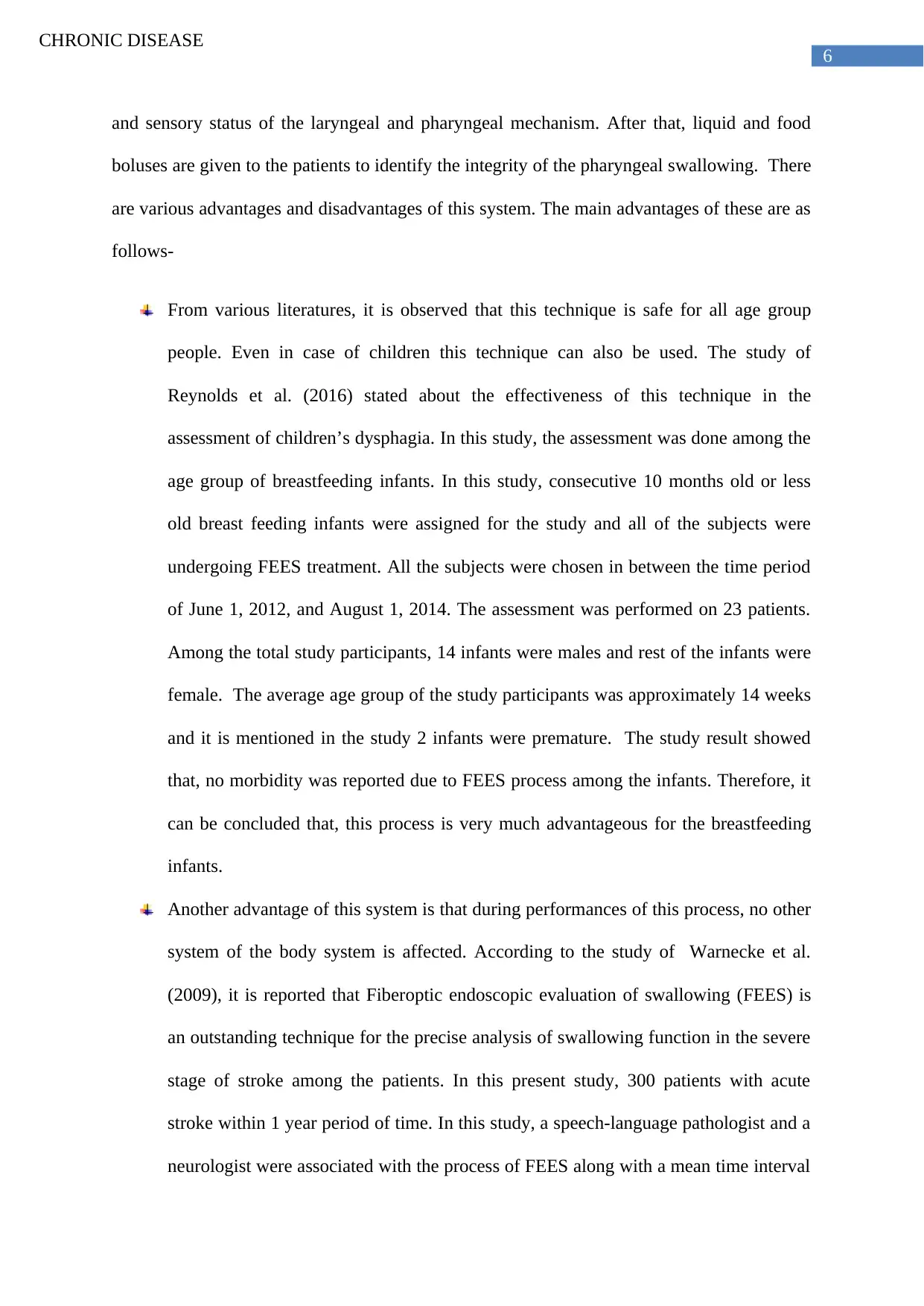
6
CHRONIC DISEASE
and sensory status of the laryngeal and pharyngeal mechanism. After that, liquid and food
boluses are given to the patients to identify the integrity of the pharyngeal swallowing. There
are various advantages and disadvantages of this system. The main advantages of these are as
follows-
From various literatures, it is observed that this technique is safe for all age group
people. Even in case of children this technique can also be used. The study of
Reynolds et al. (2016) stated about the effectiveness of this technique in the
assessment of children’s dysphagia. In this study, the assessment was done among the
age group of breastfeeding infants. In this study, consecutive 10 months old or less
old breast feeding infants were assigned for the study and all of the subjects were
undergoing FEES treatment. All the subjects were chosen in between the time period
of June 1, 2012, and August 1, 2014. The assessment was performed on 23 patients.
Among the total study participants, 14 infants were males and rest of the infants were
female. The average age group of the study participants was approximately 14 weeks
and it is mentioned in the study 2 infants were premature. The study result showed
that, no morbidity was reported due to FEES process among the infants. Therefore, it
can be concluded that, this process is very much advantageous for the breastfeeding
infants.
Another advantage of this system is that during performances of this process, no other
system of the body system is affected. According to the study of Warnecke et al.
(2009), it is reported that Fiberoptic endoscopic evaluation of swallowing (FEES) is
an outstanding technique for the precise analysis of swallowing function in the severe
stage of stroke among the patients. In this present study, 300 patients with acute
stroke within 1 year period of time. In this study, a speech-language pathologist and a
neurologist were associated with the process of FEES along with a mean time interval
CHRONIC DISEASE
and sensory status of the laryngeal and pharyngeal mechanism. After that, liquid and food
boluses are given to the patients to identify the integrity of the pharyngeal swallowing. There
are various advantages and disadvantages of this system. The main advantages of these are as
follows-
From various literatures, it is observed that this technique is safe for all age group
people. Even in case of children this technique can also be used. The study of
Reynolds et al. (2016) stated about the effectiveness of this technique in the
assessment of children’s dysphagia. In this study, the assessment was done among the
age group of breastfeeding infants. In this study, consecutive 10 months old or less
old breast feeding infants were assigned for the study and all of the subjects were
undergoing FEES treatment. All the subjects were chosen in between the time period
of June 1, 2012, and August 1, 2014. The assessment was performed on 23 patients.
Among the total study participants, 14 infants were males and rest of the infants were
female. The average age group of the study participants was approximately 14 weeks
and it is mentioned in the study 2 infants were premature. The study result showed
that, no morbidity was reported due to FEES process among the infants. Therefore, it
can be concluded that, this process is very much advantageous for the breastfeeding
infants.
Another advantage of this system is that during performances of this process, no other
system of the body system is affected. According to the study of Warnecke et al.
(2009), it is reported that Fiberoptic endoscopic evaluation of swallowing (FEES) is
an outstanding technique for the precise analysis of swallowing function in the severe
stage of stroke among the patients. In this present study, 300 patients with acute
stroke within 1 year period of time. In this study, a speech-language pathologist and a
neurologist were associated with the process of FEES along with a mean time interval
Paraphrase This Document
Need a fresh take? Get an instant paraphrase of this document with our AI Paraphraser
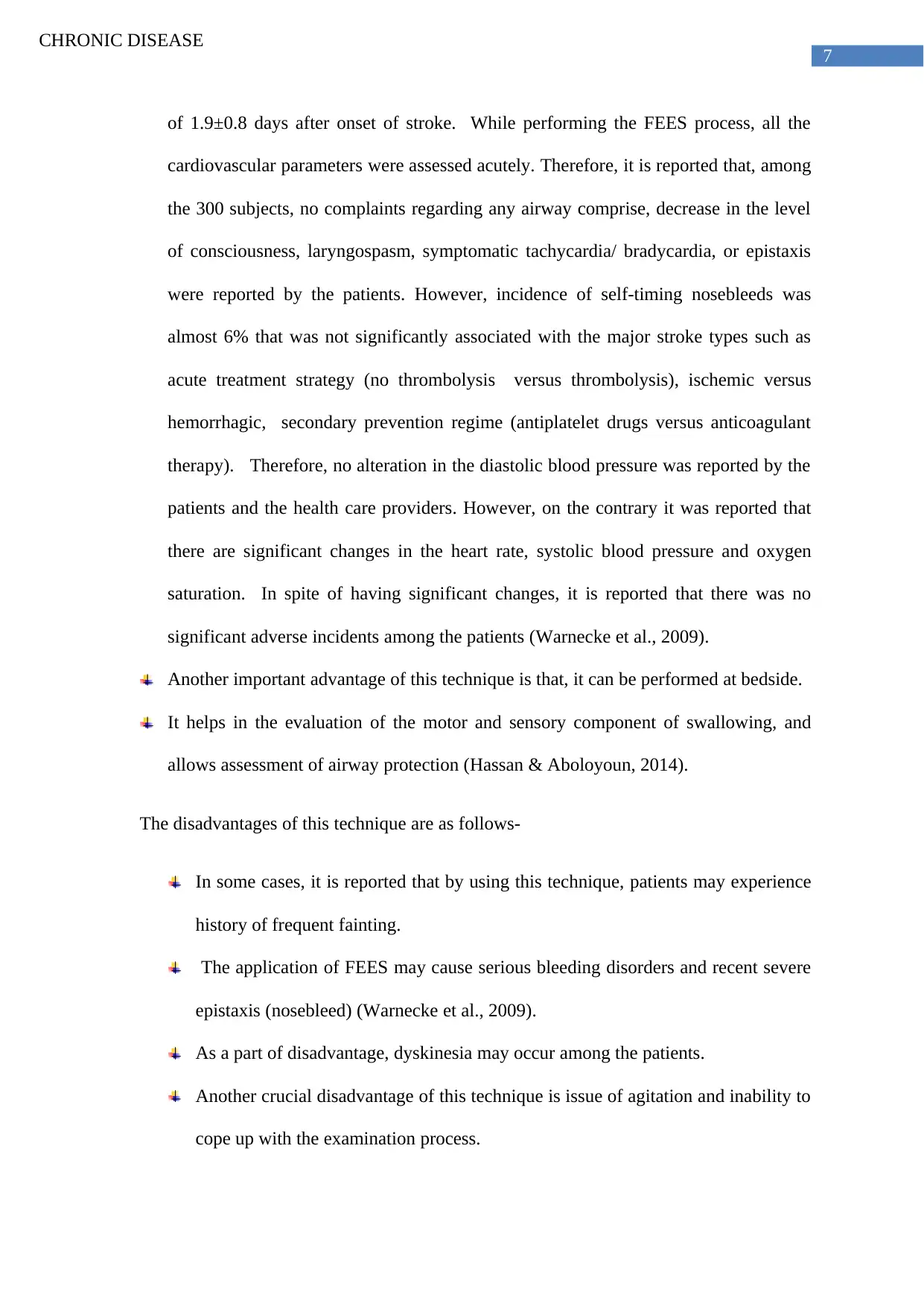
7
CHRONIC DISEASE
of 1.9±0.8 days after onset of stroke. While performing the FEES process, all the
cardiovascular parameters were assessed acutely. Therefore, it is reported that, among
the 300 subjects, no complaints regarding any airway comprise, decrease in the level
of consciousness, laryngospasm, symptomatic tachycardia/ bradycardia, or epistaxis
were reported by the patients. However, incidence of self-timing nosebleeds was
almost 6% that was not significantly associated with the major stroke types such as
acute treatment strategy (no thrombolysis versus thrombolysis), ischemic versus
hemorrhagic, secondary prevention regime (antiplatelet drugs versus anticoagulant
therapy). Therefore, no alteration in the diastolic blood pressure was reported by the
patients and the health care providers. However, on the contrary it was reported that
there are significant changes in the heart rate, systolic blood pressure and oxygen
saturation. In spite of having significant changes, it is reported that there was no
significant adverse incidents among the patients (Warnecke et al., 2009).
Another important advantage of this technique is that, it can be performed at bedside.
It helps in the evaluation of the motor and sensory component of swallowing, and
allows assessment of airway protection (Hassan & Aboloyoun, 2014).
The disadvantages of this technique are as follows-
In some cases, it is reported that by using this technique, patients may experience
history of frequent fainting.
The application of FEES may cause serious bleeding disorders and recent severe
epistaxis (nosebleed) (Warnecke et al., 2009).
As a part of disadvantage, dyskinesia may occur among the patients.
Another crucial disadvantage of this technique is issue of agitation and inability to
cope up with the examination process.
CHRONIC DISEASE
of 1.9±0.8 days after onset of stroke. While performing the FEES process, all the
cardiovascular parameters were assessed acutely. Therefore, it is reported that, among
the 300 subjects, no complaints regarding any airway comprise, decrease in the level
of consciousness, laryngospasm, symptomatic tachycardia/ bradycardia, or epistaxis
were reported by the patients. However, incidence of self-timing nosebleeds was
almost 6% that was not significantly associated with the major stroke types such as
acute treatment strategy (no thrombolysis versus thrombolysis), ischemic versus
hemorrhagic, secondary prevention regime (antiplatelet drugs versus anticoagulant
therapy). Therefore, no alteration in the diastolic blood pressure was reported by the
patients and the health care providers. However, on the contrary it was reported that
there are significant changes in the heart rate, systolic blood pressure and oxygen
saturation. In spite of having significant changes, it is reported that there was no
significant adverse incidents among the patients (Warnecke et al., 2009).
Another important advantage of this technique is that, it can be performed at bedside.
It helps in the evaluation of the motor and sensory component of swallowing, and
allows assessment of airway protection (Hassan & Aboloyoun, 2014).
The disadvantages of this technique are as follows-
In some cases, it is reported that by using this technique, patients may experience
history of frequent fainting.
The application of FEES may cause serious bleeding disorders and recent severe
epistaxis (nosebleed) (Warnecke et al., 2009).
As a part of disadvantage, dyskinesia may occur among the patients.
Another crucial disadvantage of this technique is issue of agitation and inability to
cope up with the examination process.
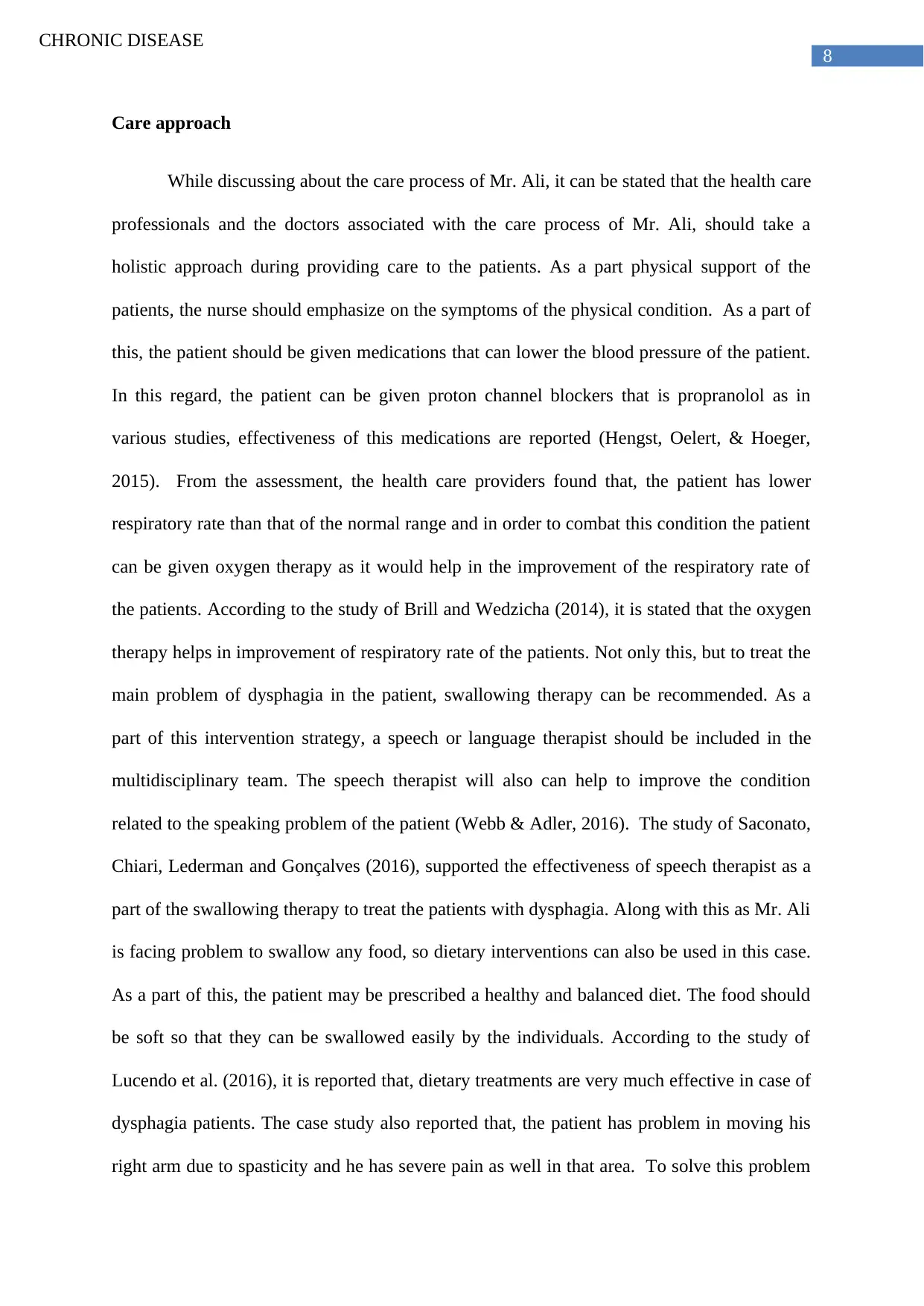
8
CHRONIC DISEASE
Care approach
While discussing about the care process of Mr. Ali, it can be stated that the health care
professionals and the doctors associated with the care process of Mr. Ali, should take a
holistic approach during providing care to the patients. As a part physical support of the
patients, the nurse should emphasize on the symptoms of the physical condition. As a part of
this, the patient should be given medications that can lower the blood pressure of the patient.
In this regard, the patient can be given proton channel blockers that is propranolol as in
various studies, effectiveness of this medications are reported (Hengst, Oelert, & Hoeger,
2015). From the assessment, the health care providers found that, the patient has lower
respiratory rate than that of the normal range and in order to combat this condition the patient
can be given oxygen therapy as it would help in the improvement of the respiratory rate of
the patients. According to the study of Brill and Wedzicha (2014), it is stated that the oxygen
therapy helps in improvement of respiratory rate of the patients. Not only this, but to treat the
main problem of dysphagia in the patient, swallowing therapy can be recommended. As a
part of this intervention strategy, a speech or language therapist should be included in the
multidisciplinary team. The speech therapist will also can help to improve the condition
related to the speaking problem of the patient (Webb & Adler, 2016). The study of Saconato,
Chiari, Lederman and Gonçalves (2016), supported the effectiveness of speech therapist as a
part of the swallowing therapy to treat the patients with dysphagia. Along with this as Mr. Ali
is facing problem to swallow any food, so dietary interventions can also be used in this case.
As a part of this, the patient may be prescribed a healthy and balanced diet. The food should
be soft so that they can be swallowed easily by the individuals. According to the study of
Lucendo et al. (2016), it is reported that, dietary treatments are very much effective in case of
dysphagia patients. The case study also reported that, the patient has problem in moving his
right arm due to spasticity and he has severe pain as well in that area. To solve this problem
CHRONIC DISEASE
Care approach
While discussing about the care process of Mr. Ali, it can be stated that the health care
professionals and the doctors associated with the care process of Mr. Ali, should take a
holistic approach during providing care to the patients. As a part physical support of the
patients, the nurse should emphasize on the symptoms of the physical condition. As a part of
this, the patient should be given medications that can lower the blood pressure of the patient.
In this regard, the patient can be given proton channel blockers that is propranolol as in
various studies, effectiveness of this medications are reported (Hengst, Oelert, & Hoeger,
2015). From the assessment, the health care providers found that, the patient has lower
respiratory rate than that of the normal range and in order to combat this condition the patient
can be given oxygen therapy as it would help in the improvement of the respiratory rate of
the patients. According to the study of Brill and Wedzicha (2014), it is stated that the oxygen
therapy helps in improvement of respiratory rate of the patients. Not only this, but to treat the
main problem of dysphagia in the patient, swallowing therapy can be recommended. As a
part of this intervention strategy, a speech or language therapist should be included in the
multidisciplinary team. The speech therapist will also can help to improve the condition
related to the speaking problem of the patient (Webb & Adler, 2016). The study of Saconato,
Chiari, Lederman and Gonçalves (2016), supported the effectiveness of speech therapist as a
part of the swallowing therapy to treat the patients with dysphagia. Along with this as Mr. Ali
is facing problem to swallow any food, so dietary interventions can also be used in this case.
As a part of this, the patient may be prescribed a healthy and balanced diet. The food should
be soft so that they can be swallowed easily by the individuals. According to the study of
Lucendo et al. (2016), it is reported that, dietary treatments are very much effective in case of
dysphagia patients. The case study also reported that, the patient has problem in moving his
right arm due to spasticity and he has severe pain as well in that area. To solve this problem
⊘ This is a preview!⊘
Do you want full access?
Subscribe today to unlock all pages.

Trusted by 1+ million students worldwide
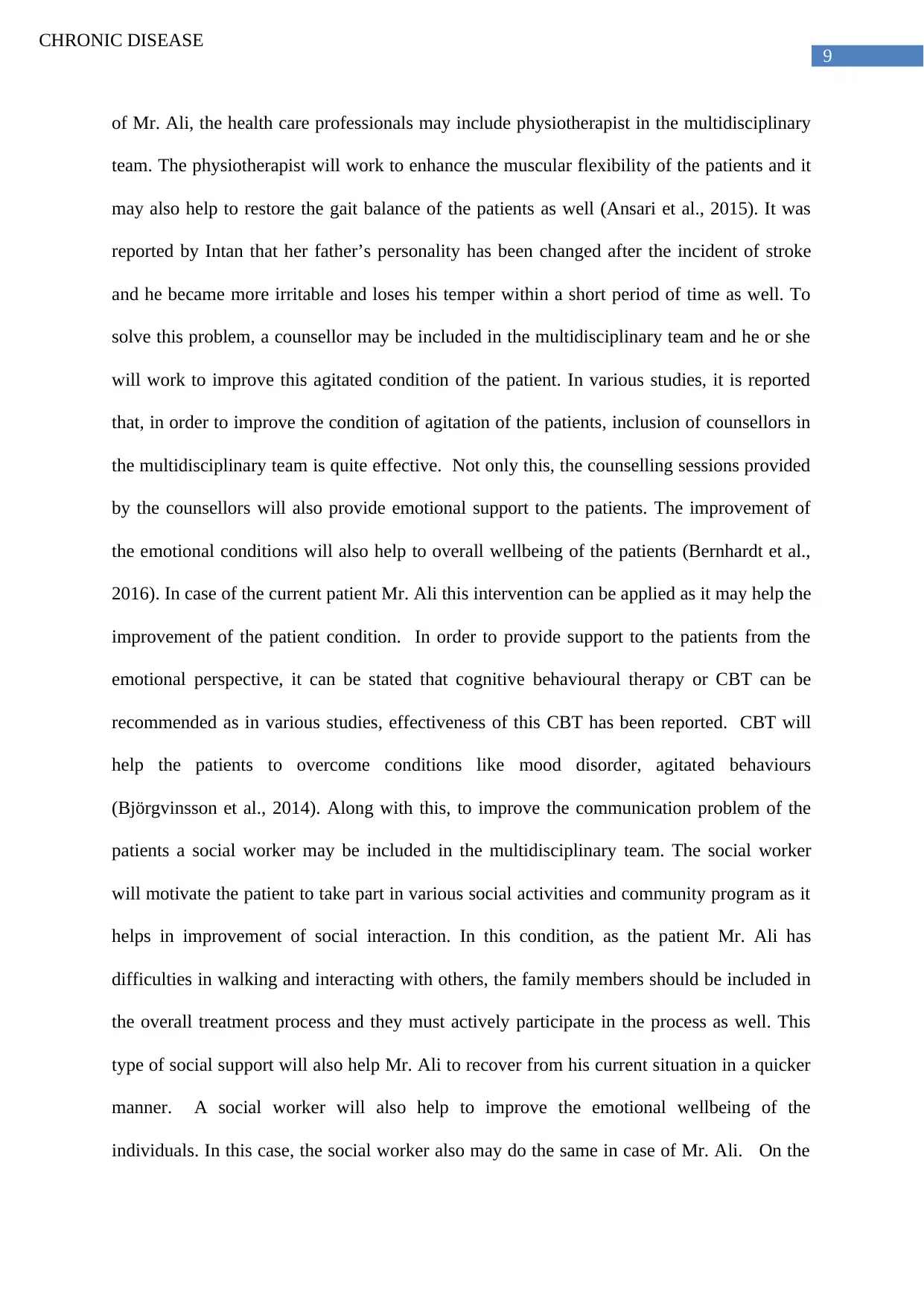
9
CHRONIC DISEASE
of Mr. Ali, the health care professionals may include physiotherapist in the multidisciplinary
team. The physiotherapist will work to enhance the muscular flexibility of the patients and it
may also help to restore the gait balance of the patients as well (Ansari et al., 2015). It was
reported by Intan that her father’s personality has been changed after the incident of stroke
and he became more irritable and loses his temper within a short period of time as well. To
solve this problem, a counsellor may be included in the multidisciplinary team and he or she
will work to improve this agitated condition of the patient. In various studies, it is reported
that, in order to improve the condition of agitation of the patients, inclusion of counsellors in
the multidisciplinary team is quite effective. Not only this, the counselling sessions provided
by the counsellors will also provide emotional support to the patients. The improvement of
the emotional conditions will also help to overall wellbeing of the patients (Bernhardt et al.,
2016). In case of the current patient Mr. Ali this intervention can be applied as it may help the
improvement of the patient condition. In order to provide support to the patients from the
emotional perspective, it can be stated that cognitive behavioural therapy or CBT can be
recommended as in various studies, effectiveness of this CBT has been reported. CBT will
help the patients to overcome conditions like mood disorder, agitated behaviours
(Björgvinsson et al., 2014). Along with this, to improve the communication problem of the
patients a social worker may be included in the multidisciplinary team. The social worker
will motivate the patient to take part in various social activities and community program as it
helps in improvement of social interaction. In this condition, as the patient Mr. Ali has
difficulties in walking and interacting with others, the family members should be included in
the overall treatment process and they must actively participate in the process as well. This
type of social support will also help Mr. Ali to recover from his current situation in a quicker
manner. A social worker will also help to improve the emotional wellbeing of the
individuals. In this case, the social worker also may do the same in case of Mr. Ali. On the
CHRONIC DISEASE
of Mr. Ali, the health care professionals may include physiotherapist in the multidisciplinary
team. The physiotherapist will work to enhance the muscular flexibility of the patients and it
may also help to restore the gait balance of the patients as well (Ansari et al., 2015). It was
reported by Intan that her father’s personality has been changed after the incident of stroke
and he became more irritable and loses his temper within a short period of time as well. To
solve this problem, a counsellor may be included in the multidisciplinary team and he or she
will work to improve this agitated condition of the patient. In various studies, it is reported
that, in order to improve the condition of agitation of the patients, inclusion of counsellors in
the multidisciplinary team is quite effective. Not only this, the counselling sessions provided
by the counsellors will also provide emotional support to the patients. The improvement of
the emotional conditions will also help to overall wellbeing of the patients (Bernhardt et al.,
2016). In case of the current patient Mr. Ali this intervention can be applied as it may help the
improvement of the patient condition. In order to provide support to the patients from the
emotional perspective, it can be stated that cognitive behavioural therapy or CBT can be
recommended as in various studies, effectiveness of this CBT has been reported. CBT will
help the patients to overcome conditions like mood disorder, agitated behaviours
(Björgvinsson et al., 2014). Along with this, to improve the communication problem of the
patients a social worker may be included in the multidisciplinary team. The social worker
will motivate the patient to take part in various social activities and community program as it
helps in improvement of social interaction. In this condition, as the patient Mr. Ali has
difficulties in walking and interacting with others, the family members should be included in
the overall treatment process and they must actively participate in the process as well. This
type of social support will also help Mr. Ali to recover from his current situation in a quicker
manner. A social worker will also help to improve the emotional wellbeing of the
individuals. In this case, the social worker also may do the same in case of Mr. Ali. On the
Paraphrase This Document
Need a fresh take? Get an instant paraphrase of this document with our AI Paraphraser
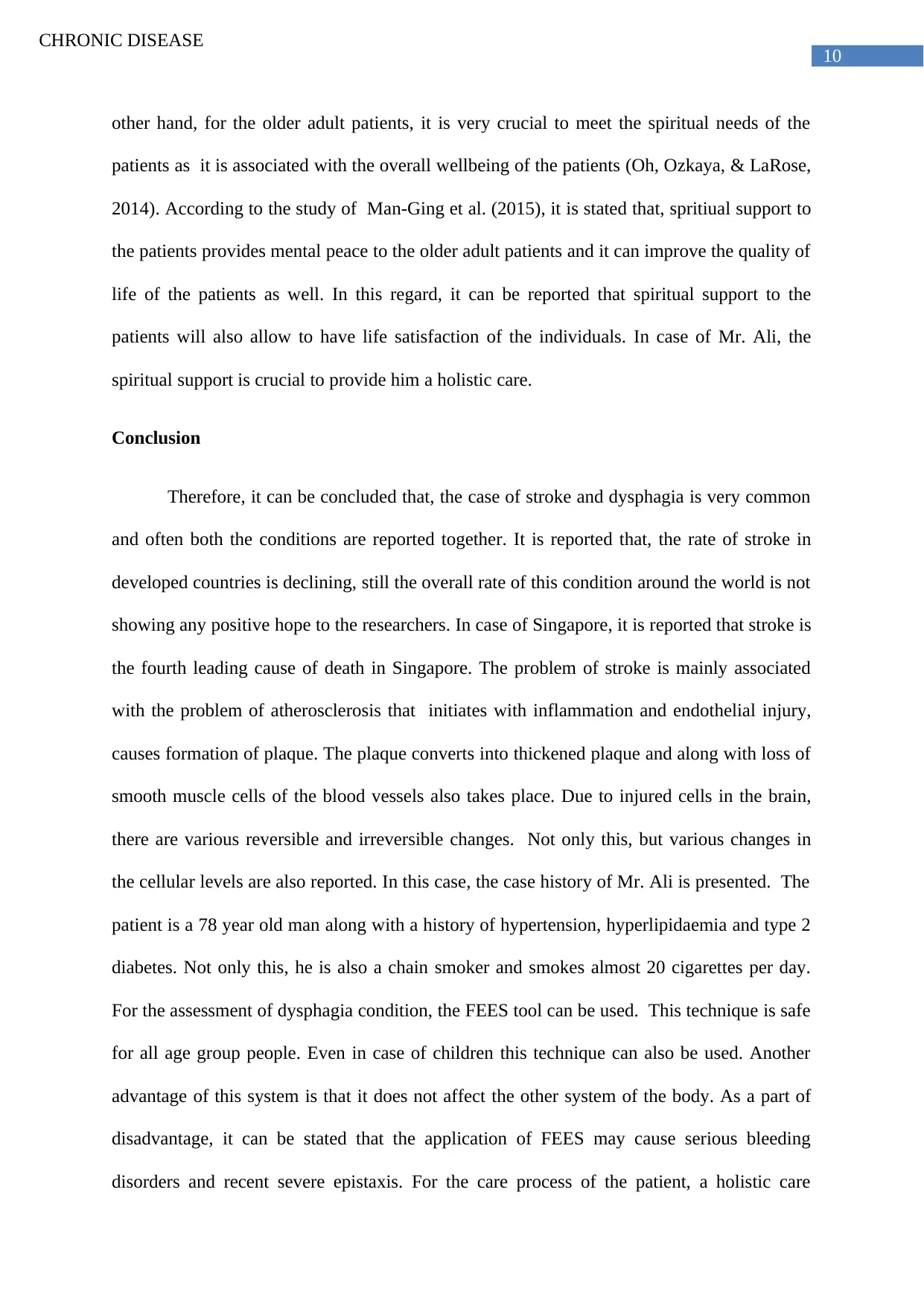
10
CHRONIC DISEASE
other hand, for the older adult patients, it is very crucial to meet the spiritual needs of the
patients as it is associated with the overall wellbeing of the patients (Oh, Ozkaya, & LaRose,
2014). According to the study of Man-Ging et al. (2015), it is stated that, spritiual support to
the patients provides mental peace to the older adult patients and it can improve the quality of
life of the patients as well. In this regard, it can be reported that spiritual support to the
patients will also allow to have life satisfaction of the individuals. In case of Mr. Ali, the
spiritual support is crucial to provide him a holistic care.
Conclusion
Therefore, it can be concluded that, the case of stroke and dysphagia is very common
and often both the conditions are reported together. It is reported that, the rate of stroke in
developed countries is declining, still the overall rate of this condition around the world is not
showing any positive hope to the researchers. In case of Singapore, it is reported that stroke is
the fourth leading cause of death in Singapore. The problem of stroke is mainly associated
with the problem of atherosclerosis that initiates with inflammation and endothelial injury,
causes formation of plaque. The plaque converts into thickened plaque and along with loss of
smooth muscle cells of the blood vessels also takes place. Due to injured cells in the brain,
there are various reversible and irreversible changes. Not only this, but various changes in
the cellular levels are also reported. In this case, the case history of Mr. Ali is presented. The
patient is a 78 year old man along with a history of hypertension, hyperlipidaemia and type 2
diabetes. Not only this, he is also a chain smoker and smokes almost 20 cigarettes per day.
For the assessment of dysphagia condition, the FEES tool can be used. This technique is safe
for all age group people. Even in case of children this technique can also be used. Another
advantage of this system is that it does not affect the other system of the body. As a part of
disadvantage, it can be stated that the application of FEES may cause serious bleeding
disorders and recent severe epistaxis. For the care process of the patient, a holistic care
CHRONIC DISEASE
other hand, for the older adult patients, it is very crucial to meet the spiritual needs of the
patients as it is associated with the overall wellbeing of the patients (Oh, Ozkaya, & LaRose,
2014). According to the study of Man-Ging et al. (2015), it is stated that, spritiual support to
the patients provides mental peace to the older adult patients and it can improve the quality of
life of the patients as well. In this regard, it can be reported that spiritual support to the
patients will also allow to have life satisfaction of the individuals. In case of Mr. Ali, the
spiritual support is crucial to provide him a holistic care.
Conclusion
Therefore, it can be concluded that, the case of stroke and dysphagia is very common
and often both the conditions are reported together. It is reported that, the rate of stroke in
developed countries is declining, still the overall rate of this condition around the world is not
showing any positive hope to the researchers. In case of Singapore, it is reported that stroke is
the fourth leading cause of death in Singapore. The problem of stroke is mainly associated
with the problem of atherosclerosis that initiates with inflammation and endothelial injury,
causes formation of plaque. The plaque converts into thickened plaque and along with loss of
smooth muscle cells of the blood vessels also takes place. Due to injured cells in the brain,
there are various reversible and irreversible changes. Not only this, but various changes in
the cellular levels are also reported. In this case, the case history of Mr. Ali is presented. The
patient is a 78 year old man along with a history of hypertension, hyperlipidaemia and type 2
diabetes. Not only this, he is also a chain smoker and smokes almost 20 cigarettes per day.
For the assessment of dysphagia condition, the FEES tool can be used. This technique is safe
for all age group people. Even in case of children this technique can also be used. Another
advantage of this system is that it does not affect the other system of the body. As a part of
disadvantage, it can be stated that the application of FEES may cause serious bleeding
disorders and recent severe epistaxis. For the care process of the patient, a holistic care
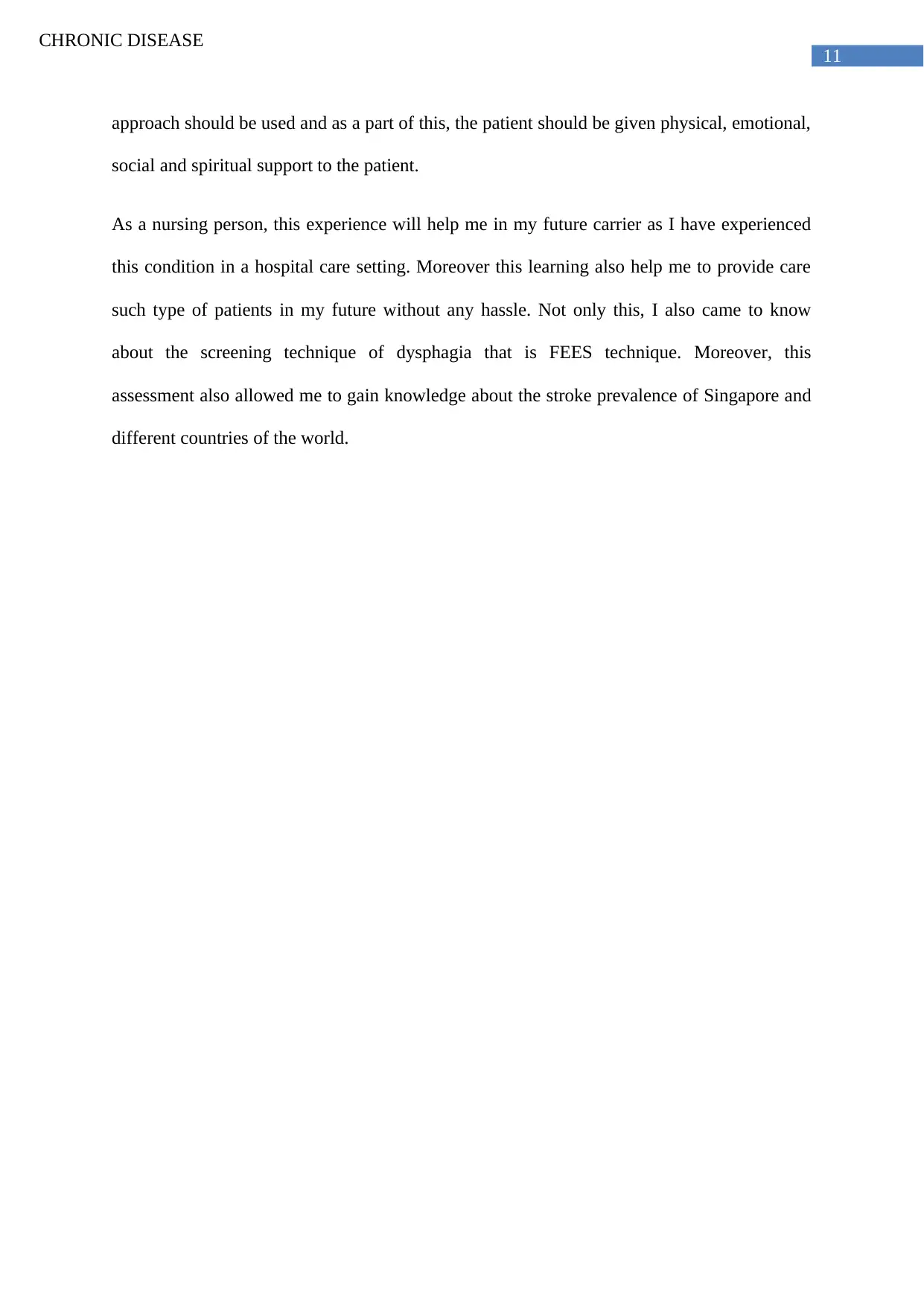
11
CHRONIC DISEASE
approach should be used and as a part of this, the patient should be given physical, emotional,
social and spiritual support to the patient.
As a nursing person, this experience will help me in my future carrier as I have experienced
this condition in a hospital care setting. Moreover this learning also help me to provide care
such type of patients in my future without any hassle. Not only this, I also came to know
about the screening technique of dysphagia that is FEES technique. Moreover, this
assessment also allowed me to gain knowledge about the stroke prevalence of Singapore and
different countries of the world.
CHRONIC DISEASE
approach should be used and as a part of this, the patient should be given physical, emotional,
social and spiritual support to the patient.
As a nursing person, this experience will help me in my future carrier as I have experienced
this condition in a hospital care setting. Moreover this learning also help me to provide care
such type of patients in my future without any hassle. Not only this, I also came to know
about the screening technique of dysphagia that is FEES technique. Moreover, this
assessment also allowed me to gain knowledge about the stroke prevalence of Singapore and
different countries of the world.
⊘ This is a preview!⊘
Do you want full access?
Subscribe today to unlock all pages.

Trusted by 1+ million students worldwide
1 out of 18
Related Documents
Your All-in-One AI-Powered Toolkit for Academic Success.
+13062052269
info@desklib.com
Available 24*7 on WhatsApp / Email
![[object Object]](/_next/static/media/star-bottom.7253800d.svg)
Unlock your academic potential
Copyright © 2020–2025 A2Z Services. All Rights Reserved. Developed and managed by ZUCOL.





